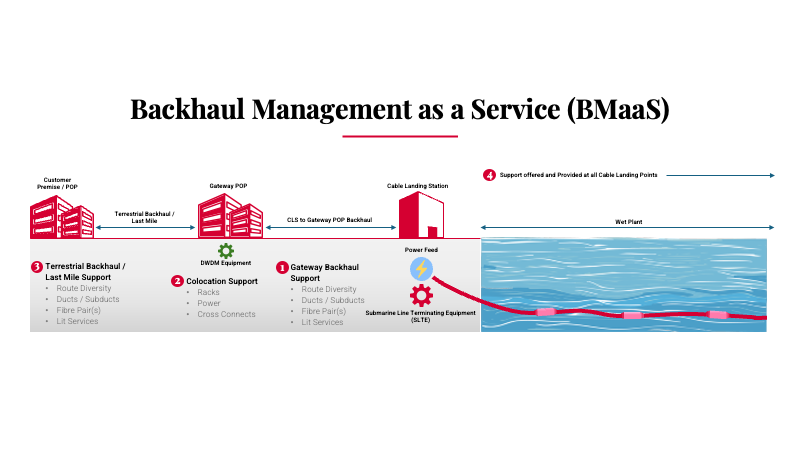The Critical Role of Backhaul Management in Submarine Network Topology & Operations
Introduction
In today's interconnected world, submarine cable networks form the backbone of global communication, enabling the seamless exchange of data across continents.
While these undersea cables are the epitome of engineering marvels, their effectiveness hinges not only on the ‘wet' network in the seabed, but also on the often-overlooked terrestrial network backhaul.
The terrestrial backhaul — the infrastructure that connects submarine cable landing stations to inland data centres and networks — is as crucial as the submarine network itself. Proper management and handling of terrestrial backhaul partners is essential to ensure the optimal performance, cost-efficiency, and security of all submarine networks.
The Vital Importance of Backhaul Management
Submarine networks are only as strong as their weakest link, and the terrestrial backhaul is a pivotal link in this ecosystem. Without a well-designed and managed backhaul, even the most sophisticated submarine network can face inefficiencies, bottlenecks, and vulnerabilities.
Key reasons why managing terrestrial network backhaul partners is so critical include:
Cost Optimisation
Terrestrial backhaul costs constitute a significant portion of the total network expenditure. Poorly negotiated contracts or suboptimal supplier relationships can inflate operational costs, diminishing the overall profitability of submarine networks.
Network Performance
The design, quality, and reliability of terrestrial backhaul networks directly affect latency, throughput, and overall user experience. A poorly managed partner ecosystem can lead to performance degradation, affecting service delivery.
Security and Risk Mitigation
The terrestrial segment is often more vulnerable to physical and cyber threats compared to submarine cables. Effective partner management ensures that security measures are prioritised, and risks are mitigated.
Scalability and Flexibility
As data demands grow, submarine networks must scale effectively. Well-managed terrestrial backhaul partners enable seamless scaling and adaptability to meet changing requirements.
How We Can Help
Introducing Cambridge Management Consulting’s ‘Backhaul Management As A Service (BMaaS)’, which we’ve put together to address the challenges which we see facing our customers when it comes to designing and building a holistic submarine network inclusive of the terrestrial backhaul.
'Backhaul Management As A Service (BMaaS)', offers a comprehensive suite of services designed to simplify, streamline, and optimise the implementation, and subsequent management, of terrestrial backhaul partners.
BMaaS offers a holistic approach, encompassing strategy, procurement, supplier management, and much more.
Key Components of Cambridge MC’s BMaaS
- Strategy: We design a glidepath that ensures the acquisition of successful backhaul partners at the right price, with an optimal network design and secure performance.
- Supplier Management as a Service (SMaaS): A turn-key solution for managing all procurement activities. This service secures best practices and achieves the most optimised cost models.
- Procurement Management as a Service (PaaS): Our off-the-shelf procurement services streamline and execute the lifecycle of backhaul partnerships.
- Contract Management as a Service (CMaaS): This addresses the complex challenges of managing contracts and suppliers post-signature, ensuring adherence to terms and performance metrics.
- Pricing Team Support: Offering robust pricing support and managing RFP/RFQ processes to deliver strategies and solutions for procurement exercises that lie outside normal business-as-usual operations.
- Invoice & Inventory Auditing & Analytics: A critical review of backhaul services, including supplier inventory and billing, to ensure alignment with contractual agreements.
Summary of Benefits
In conclusion, while submarine networks are critical to global connectivity, their full potential can only be fully realised with effective terrestrial backhaul management. Cambridge Management Consulting’s BMaaS offering provides a structured, strategic, and results-driven approach to managing terrestrial network backhaul partners, ensuring cost-efficiency, performance, and security.
By leveraging BMaaS, clients can navigate the complexities of backhaul management with confidence, unlocking the true value of their submarine network investments, and exploit Cambridge Management Consulting’s vast experience in this sector.
For more information email the team at info@cambridgemc.com or use the contact form below.
Contact - Backhaul Management article
Subscribe to our Newsletter
Blog Subscribe
SHARE CONTENT













